
WAN Link Specifications
Wide-Area Networks
Wide-Area Networks or WAN links are telecommunications infrastructure connecting networks across broad geographic areas. They typically have the topology of point to point connections. This is what carriers and backbone providers use to connect cities.
Digital Signal X is a series of digital transmission rates based on DS0. The North American T-carrier and European E-carrier systems use these:
| DSX | Bit rate | Number of DS0 links multiplexed together with TDM |
Used for |
| DS0 | 64 Kbps | — | One telephone voice channel |
| DS1 | 1.544 Mbps | 24 | T1 |
| — | 2.048 Mbps | 32 | E1 |
| DS1C | 3.152 Mbps | 48 | — |
| DS2 | 6.312 Mbps | 96 | T2 |
| — | 8.448 Mbps | 128 | E2 |
| — | 34.368 Mbps | 512 | E3 |
| DS3 | 44.736 Mbps | 672 | T3 |
| — | 139.264 Mbps | 2048 | E4 |
| DS4/NA | 139.264 Mbps | 2176 | — |
| DS4 | 274.176 Mbps | 4032 | — |
| — | 565.148 Mbps | 8192 | E5 |
The T-carrier system was introduced by Bell in the U.S. in the 1960's. It uses time-division multiplexing to interleave multiple pulse-code modulation signals on a shielded conductor in each direction. Twisted pair at lower speeds, coaxial cables or optical fibre at higher speeds. E-carrier is similar, used in Europe. E-carrier can support higher data rates for a given bit rate as it uses all eight bits per channel for signal coding.
SONET (Synchronous Optical Network) is much faster — you're generally talking about Internet backbone links.
| Format | Data rate |
| T1 | 1.544 Mbps |
| E1 | 2.048 Mbps |
| T1C | 3.152 Mbps |
| T2 | 6.312 Mbps |
| E2 | 8.448 Mbps |
| E3 | 34.368 Mbps |
| T3 | 44.736 Mbps |
| T3D | 135 Mbps |
| E4 | 139.264 Mbps |
| E5 | 565.148 Mbps |
| Format | Data rate |
| OC-1 | 51.84 Mbps |
| OC-3 | 155.52 Mbps |
| OC-12 | 622.08 Mbps |
| OC-24 | 1.244 Gbps |
| OC-48 | 2.488 Gbps |
| OC-192 | 10 Gbps |
| OC-256 | 13.271 Gbps |
| OC-768 | 40 Gbps |
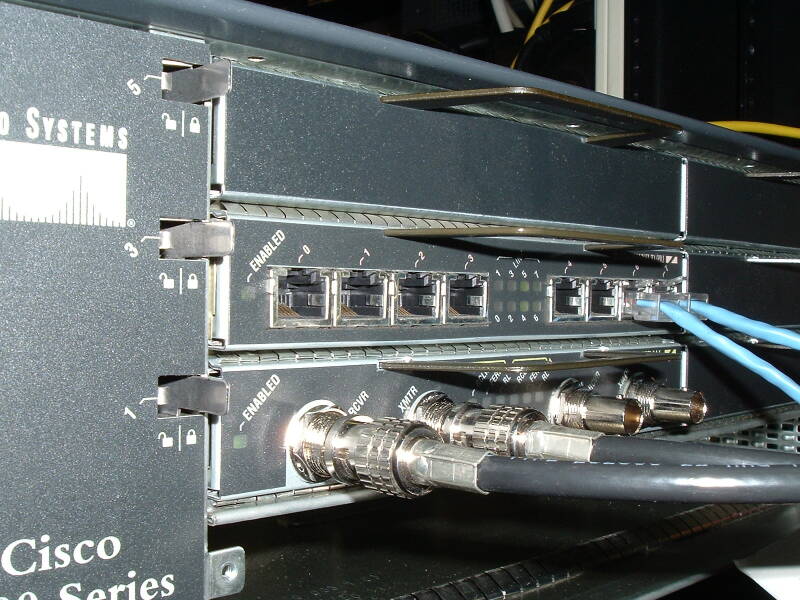
DS3 interfaces on a Cisco 7000 series router.
And then there's a grab-bag of other technologies:
| Format | Data rate |
| GSM mobile telephone | 9.6-14.4 kbps |
| POTS (Plain Old Telephone Service) | Up to 56 kbps |
| GPRS (General Packet Radio System) | 56-114 kbps |
| ISDN BRI | 64-128 kbps |
| IDSL | 128 kbps |
| Frame relay | 56 kbps — 1.544 Mbps |
| DSL | 512 kbps — 8 Mbps |
| SDSL, HDSL | 1.544 Mbps |
| ADSL | 16—784 kbps upstream, 1—9 Mbps downstream |
| VDSL | Up to 52 Mbps downstream (max distance 1000-4500 feet) |
| Cable modems | 512 kbps — 52 Mbps 10 Mbps or less to node |
| HSSI (High-Speed Serial Interface), up to 50 feet router-to-WAN connection | Up to 53 Mbps |
| FDDI (Fiber Distributed Data Interface), used for corporate/campus WANs | 100 Mbps |
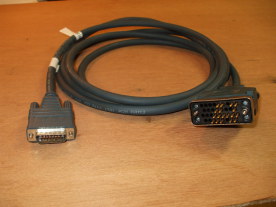
Cisco V.35 cable used to connect to a T1/DS1 WAN link.
James Bamford's The Shadow Factory: The NSA from 9/11 to the Eavesdropping on America is an investigative history of the NSA over the period 2001-2008. It summarizes the U.S. landing points of many of the trans-ocean communication cables and some major U.S. IXP (Internet Exchange Point), MAE (Metropolitan Area Ethernet, a form of IXP), and NAP (National Access Point) sites:
Amazon
ASIN: 0307279391
California
San Luis Obispo, California is the AT&T landing point for five out of six trans-Pacific cables. They come in under the beach at Montana de Oro State Park and run "2,200 feet through a 5-inch drill pipe to a manhole," then run a mile to 9401 Los Oso Valley Road in San Luis Obispo.
San Francisco, California notoriously has the major IXP on the 7th floor of 611 Folsom Street. One floor down is room 641A, labeled "SG3" for "Study Group 3", where the NSA captures traffic with a Narus STA 6400.
San Jose, California has MAE West on the 11th floor of 55 Market Street.
Los Angeles, California has the Any2 Exchange at One Wilshire. It is a major interconnection point for the Pacific Rim countries.
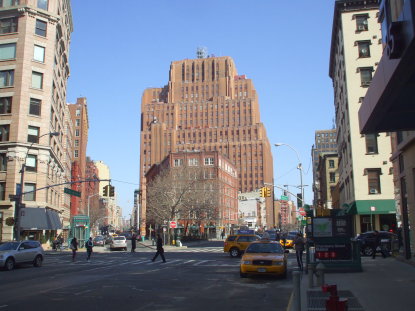
60 Hudson Street, the former Western Union Building and still a major telecommunications interconnection point.
New Jersey / New York
Tuckerton NJ and the surrounding area is the landing site for a number of cables to Europe, the Caribbean, and South America.
New York, New York has 60 Hudson Street, the former Western Union Building and its headquarters until 1973, and still a major world communications nexus. It's a carrier hotel with over 100 telecommunications companies interchanging Internet traffic. Another major carrier hotel is at 60 Broad Street, just off Wall Street.
See my page dedicated to the visible telecommunications infrastructure in Manhattan for more.
Virginia / Washington DC
Vienna, Virginia has MAE East at Suite 400, 8100 Boone Boulevard. It used to be in the corner of the parking garage.... That's just across Leesburg Pike from the Tysons Corner Shopping Center.
Ashburn VA has the Equinex IXP at 21830 UUNET Way.
Florida
Miami, Florida has the NAP of the Americas at 50 NE 9th Street. It's owned by Terramark and routes traffic between Latin American countries and handles about 90% of the traffic between North and South America.
Mid-Continent
Bridgeton, Missouri is the site of AT&T's Network Operations Center, at 12976 Hollenberg Drive.
There are many more, see these links for lists:
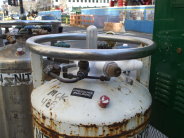
Frost forming on the cold dewar from which liquid nitrogen is being drawn.
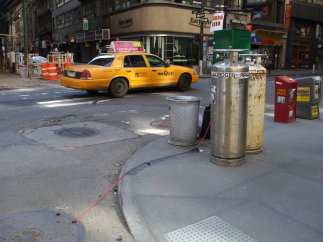
Two liquid nitrogen dewars on the corner of Broadway and John Street on the edge of the Financial District in Lower Manhattan. Nitrogen is most efficiently stored and transported in liquid form. The red hose running across the sidewalk and down into the manhole provides a constant supply of dry nitrogen for the conduits carrying the many telecommunications circuits running underground.
This is the Verizon switching center on Charles Street at East Pleasant, in Baltimore, Maryland. You know that there has to be a fat pipe between here and the nearby Fort Meade.



